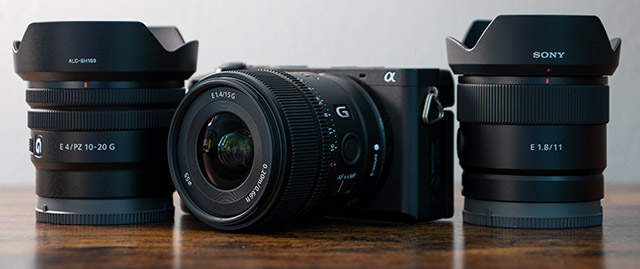Hands-on with three new Sony APS-C lenses: 11mm F1.8, 15mm F1.4 G and 10-20mm F4 PZ G
posted Wednesday, June 1, 2022 at 9:00 AM EST

Sony has been busy lately, releasing the FE PZ 16-35mm F4 G and FE 24-70mm F2.8 GM II zoom lenses in the past couple of months. Those two lenses are for full-frame cameras, although they can, of course, be used on Sony's crop cameras. Now Sony has something in store specifically for its APS-C users. In fact, not just one new lens, but three.
The Sony 11mm F1.8, 15mm F1.4 G and 10-20mm F4 PZ G lenses are compact, lightweight and designed for hybrid applications. As we've seen with many of Sony's recent lenses, Sony is catering more to the growing group of users who don't exclusively capture still photos but record video, too, whether casually or seriously. Hybrid users are no longer the exception. They're the norm.

Why opt to release APS-C lenses? While Sony's full-frame cameras are very popular and the userbase large, the affordability and the compact/lightweight design of APS-C cameras and lenses have wide appeal. While there's no harm in using full-frame FE lenses on an APS-C camera – a lot of people do it – the larger full-frame lenses slightly reduce the size advantage of APS-C cameras.
There's no doubt that Sony has primarily focused on its full-frame lenses in the last few years. The last APS-C lens announced was the 16-55mm F2.8 back in the summer of 2019. After a long hiatus, Sony wanted to better serve the needs of its A6000-series users and people using the ZV-E10 vlogging camera. The Sony lens lineup is a bit thin for these users, especially at the wide end. Before today's announcement, customers could choose between the 10-18mm F4 OSS, 16mm F2.8, 20mm F2.8 and 24mm F1.8 if they wanted a compact wide-angle lens. There's not much to choose from, especially if you want a fast, wide lens.

With the new 11mm F1.8, 15mm F1.4 G and 10-20mm F4 PZ G lenses, customers now have significantly expanded choices. The 11mm F1.8 and 15mm F1.4 G are both wider than any previous Sony APS-C wide-angle prime lenses. Despite being a zoom lens, the 10-20mm F4 PZ G remains a relatively compact form factor. The trio of new lenses brings Sony's total number of lenses (including converters) to 70, of which 23 are APS-C.
Sony 10-20mm F4 PZ G
The Sony 10-20mm F4 PZ G, which delivers a 15-30mm equivalent focal length range, is the smallest and lightest ultra-wide-angle APS-C zoom lens of its type. You can use the 10-20mm at the wide end for selfie photos/video, but its perspective is more natural at the longer end. The lens is also highly rectilinear at its wide end, making it a good choice for many wide-angle applications.

The 10-20mm is 22% lighter than the E 10-18mm F4 OSS lens. Considering that the new lens is a Power Zoom (PZ) zoom, and it's a 2x zoom rather than a 1.8x zoom, that's quite the accomplishment. OSS is omitted from the new lens, so you must rely on in-body image stabilization. The 10-20mm F4 PZ is also shorter. It's 5.49 cm (2.16 in.) versus 6.35 cm (2.5 in.). The lens is a constant length, too, whereas the 10-18mm extends as you zoom, making the size difference even starker.

Sony's Linear AF Motors, which have been included in many of Sony's recent lenses, are featured in the new 10-20mm F4 PZ G. The lens delivers fast, quiet and decisive autofocus. When using autofocus, the lens can focus as close as 19.99 cm (7.87 in.), resulting in a maximum magnification of 0.14x. When using manual focus, the lens can focus closer. At 10mm, the minimum focus distance is 12.98 cm (5.11 in.). At 20mm, it's 16.99 cm (6.69 in.). The maximum magnification when manually focusing is 0.18x.

The 10-20mm F4 PZ G features a new responsive internal power zoom system. The operation is designed for stills and video, and the zoom ring is responsive. It doesn't feel quite like a physically linked zoom ring, but it's not dramatically different in practice. The zoom can also be controlled via a rocker switch on the lens or when using compatible camera bodies. You can also customize the zoom ring direction when using a compatible camera body.

When considering image quality, there's a lot to like with the 10-20mm F4 PZ G. It includes 11 lens elements across 8 groups, including a pair of ED elements, three aspherical elements and an extra-low dispersion aspherical lens. It's a "G" lens rather than a "GM" lens, so there aren't any XA elements included in the lens. In fact, as of now, there aren't any G Master lenses for APS-C. The lens delivers impressive sharpness and exhibits strong control of chromatic aberrations and fringing.

Sony 11mm F1.8
The 11mm F1.8 is Sony's widest APS-C prime lens, offering an equivalent focal length of just over 16mm. The ultra-wide lens promises excellent corner-to-corner resolution. Unlike the other two new lenses, the 11mm F1.8 isn't a "G" lens, so it's not built to quite the same standard as the 10-20mm F4 or the 15mm F1.4. That said, the lens still has good build quality. It feels good in the hands and is very compact and lightweight. It weighs 179g (6.3 oz.) and is 5.74 cm (2.26 in.) long. Despite being faster and wider, the lens is slightly shorter and lighter than Samyang's AF 12mm F2 lens. The lens also includes dust and moisture resistance thanks to multiple seals through the barrel, including at the lens mount.

As for image quality, the lens performs well. It does a good job suppressing chromatic aberration and delivers good sharpness. Despite the short focal length, the large F1.8 aperture allows you to get a somewhat defocused background. The lens can also focus as close as 12 cm (4.72 in.), resulting in a max magnification of 0.2x.


The 11mm F1.8 is a good match for Sony's compact and lightweight APS-C camera bodies. It's not as versatile as the 10-20mm zoom or as fast as the 15mm F1.4 prime, but it's a nice ultra-wide-angle lens that has value in the Sony APS-C ecosystem.


Sony 15mm F1.4 G
At the risk of sounding like a broken record, the Sony 15mm F1.4 G is also an impressively small and compact lens. It weighs just 218g (7.7 oz.), which is 45% lighter than the Sigma 16mm F1.4 DC DN lens. The Sony 15mm F1.4 G is 6.93 cm (2.73 in.) long, much shorter than the Sigma lens, which is 9.25 cm (3.64 in.) long. Sony's lens is also narrower.


The 15mm F1.4 G also promises excellent corner-to-corner resolution and strong control of aberrations. During my brief hands-on time with the lens, it lived up to the promise and delivered good image quality. Thanks to the F1.4 maximum aperture, the lens also offers nice bokeh and a shallow depth of field.

The lens includes an aperture control ring, which is a nice touch. It can be switched between "clicked" and "smooth" rotation, so you can quietly adjust the aperture during video recording. The lens also includes Linear Response MF and has a focus hold button. The lens, like the other two, includes a pair of Linear AF Motors for smooth, quiet and quick autofocus performance.

As for close-focusing performance, it's the "worst" of the three new lenses, but it's still decent. The lens can focus as close as 20 cm (7.87 in.) with autofocus and 17 cm (6.69 in.) with manual focus, resulting in maximum magnification of 0.12x and 0.15x, respectively. With that close-up performance, you can capture images with a pretty soft background. It's an okay focal length for environmental portraits, although it doesn't offer the same pleasing perspective as the 10-20mm at its long end. Of course, the bokeh is nicer thanks to the 15mm lens's faster aperture.

The Sony 15mm F1.4 G is an impressive prime lens, thanks to its compact and lightweight design and good image quality.
Summary and pricing
All three of the new Sony APS-C lenses serve a unique purpose in Sony's expanded lens lineup. The Sony 11mm F1.8 lens is impressively small and lightweight. It's also Sony's widest APS-C prime lens. Its image quality is quite nice, too, despite the lens not having "G" series designation. The lens will cost $550 ($700 CAD).

The other prime lens, the 15mm F1.4 G, is a lovely wide-angle prime lens. It offers a similar field of view as a 24mm F1.4 lens, although it's slightly wider than that. Thanks to its field of view, fast aperture, and impressive image quality, it's well-suited to a range of applications. While all three new lenses are surprisingly compact, the 15mm F1.4 G is perhaps the most surprisingly compact and lightweight of them all. The lens is $750 ($950 CAD).

Rounding out the lineup is the new zoom, the E 10-20mm F4 PZ G lens. It's the slowest lens, but since it's a zoom lens, it's also the most versatile of the new lenses, at least when not shooting in low light. It fills a similar role as Sony's existing 10-18mm F4 OSS lens, but the new zoom is smaller, lighter and better optically. Plus, it includes Linear AF Motors – like the other two new lenses – and is a Power Zoom lens. All three lenses are well-suited to video, but it seems to me that the 10-20mm zoom best represents Sony's increased focus on making lenses for hybrid users. The lens will cost $750 ($950 CAD).
All three lenses will be available to order beginning tomorrow, and Sony expects shipping to begin in early July.